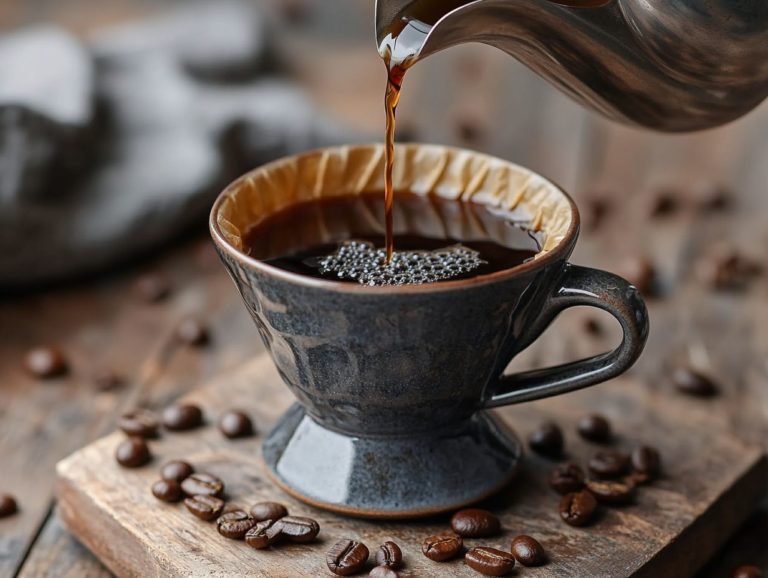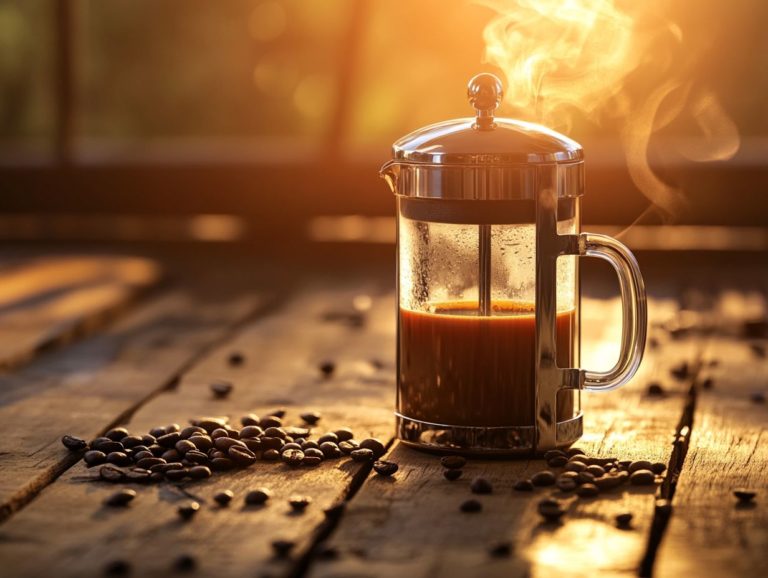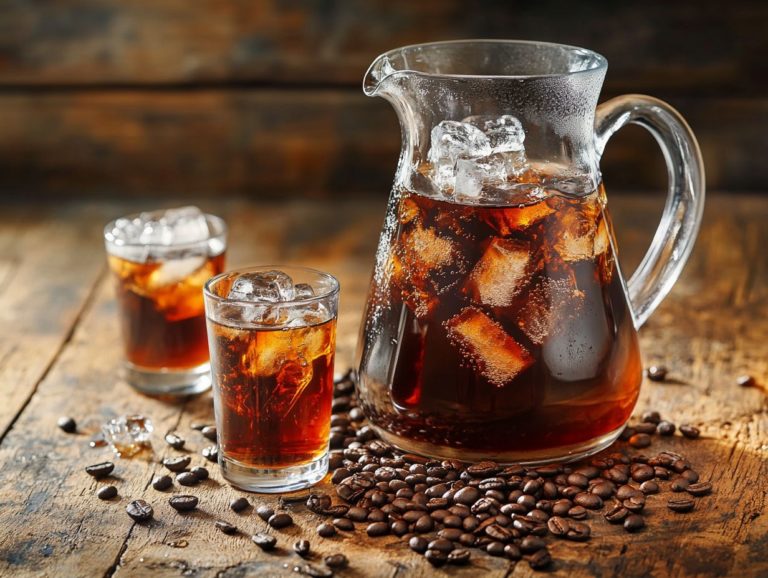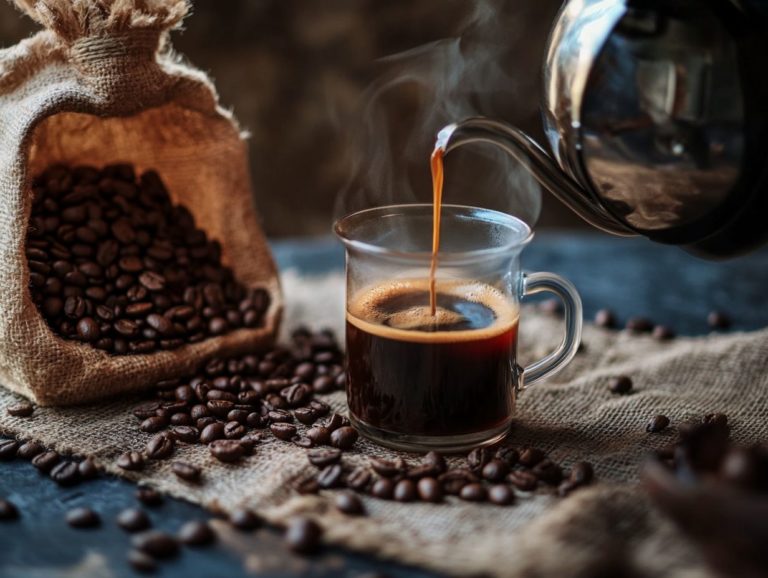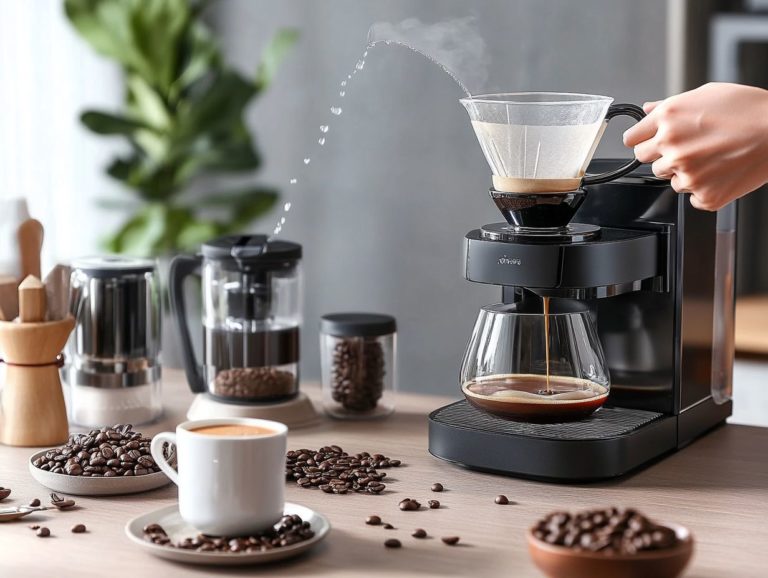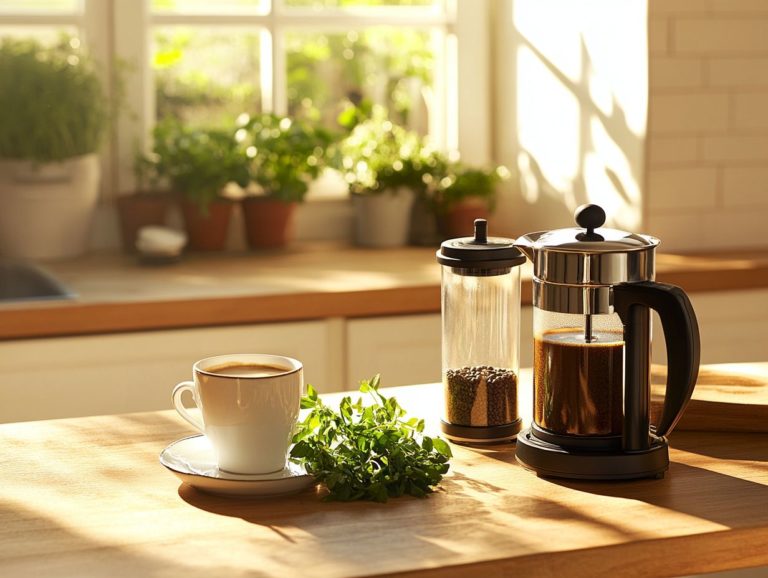Exploring the Pour Over Coffee Method
Ready to brew the perfect cup of pour-over coffee? Let’s dive in! Pour-over coffee is capturing the attention of coffee enthusiasts everywhere, celebrated for its ability to extract rich flavors and captivating aromas that many other brewing methods, including drip coffee, often overlook.
This guide is your comprehensive resource on the pour-over technique, detailing everything from the essential equipment and ideal coffee beans to the perfect grind size, water temperature, and brewing ratios. It delves into the unique characteristics that distinguish pour-over from other brewing methods, highlighting both its advantages and potential drawbacks. Start your journey today and discover the art of pour-over coffee!
Whether you’re a seasoned barista, coffee connoisseur, or simply a curious newcomer, you’ll discover valuable tips to elevate your pour-over experience to new heights.
Contents
- Key Takeaways:
- What is the Pour-Over Coffee Method?
- How to Make Pour Over Coffee?
- What Type of Coffee Beans Should You Use?
- What Grind Size is Best for Pour Over Coffee?
- What is the Ratio of Coffee to Water for Pour Over Coffee?
- What Makes Pour Over Coffee Different from Other Brewing Methods?
- What are the Benefits of Using the Pour Over Coffee Method?
- Portability and Flexibility
- Are There Any Drawbacks to Using the Pour Over Coffee Method?
- Requires More Time, Attention, and Equipment
- May Be More Expensive in the Long Run but Worth It
- Mastering the Art of Pour-Over Coffee
- Tips for Making the Perfect Pour Over Coffee
- Frequently Asked Questions
- What is the Pour Over Coffee Method?
- What equipment do I need to explore the Pour Over Coffee Method?
- Why should I use the Pour Over Coffee Method?
- How do I choose the right grind size for Pour Over Coffee?
- What is the recommended water temperature for Pour Over Coffee?
- Can I use the Pour Over Coffee Method for any type of coffee beans?
Key Takeaways:
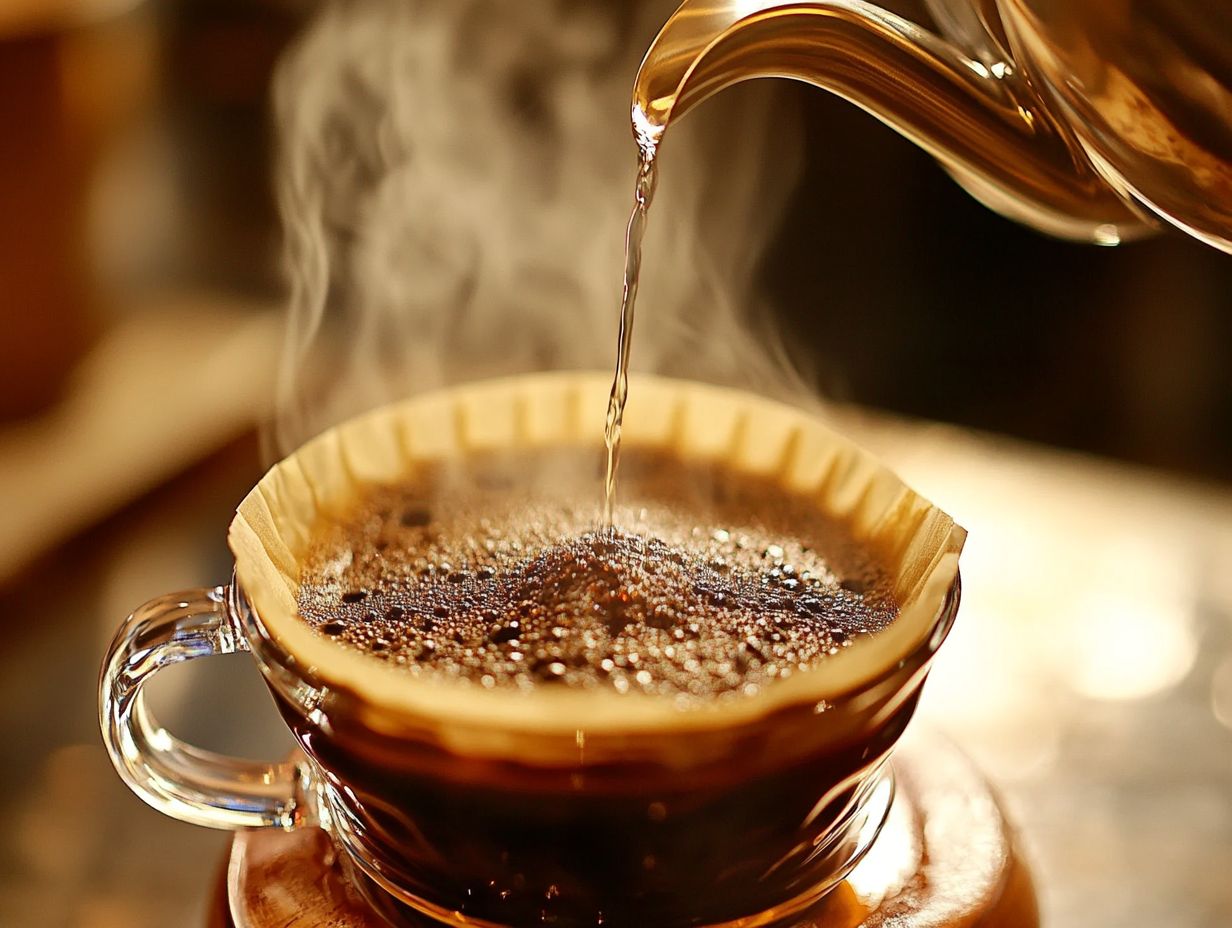
- The pour-over coffee method offers enhanced flavor, control over the brewing process, and ease of cleanup compared to other brewing methods.
- To make the perfect pour-over coffee, use freshly roasted beans, experiment with grind sizes, preheat your equipment, and practice pouring technique.
- While the pour-over method requires more time and attention, it is a portable and cost-effective way to enjoy a delicious cup of coffee.
What is the Pour-Over Coffee Method?
The pour-over coffee method is an exquisite manual brewing process that gives you the power to extract the finest flavor profile from your coffee grounds. This technique requires a careful balance of water temperature, brew time, and the artful act of pouring, making it a popular choice among coffee lovers who relish a hands-on brewing experience.
By controlling each variable in the extraction process, you have the opportunity to craft a cup of coffee that accentuates the unique characteristics of the beans, delivering a rich and satisfying experience that is truly unparalleled.
How to Make Pour Over Coffee?
Making pour-over coffee is a truly rewarding experience, one that gives you the power to customize each cup to your exact taste preferences. It all starts with choosing the right coffee maker and dripper, like the Hario V60 or Chemex.
This brewing method is popular for its ability to elevate the intricate nuances of coffee, thanks to your careful control over essential variables such as water quality and brewing ratios. It’s no wonder this technique has become a beloved choice among discerning coffee enthusiasts.
What Equipment Do You Need?
To brew the perfect cup of pour-over coffee, you ll want to invest in specific equipment that elevates the brewing process and ensures optimal flavor extraction. Essential tools include a high-quality coffee dripper, like the Hario V60 or Chemex, a precise kettle for controlling water temperature, a reliable grinder for freshly ground coffee, a digital scale for accurate measurements, and coffee filters that fit your dripper.
Every component is integral to crafting an exceptional brew, as they collectively contribute to the final taste experience. The design of the dripper influences how water flows through the coffee grounds, allowing for uniform extraction of oils and flavors.
A precise kettle maintains optimal brewing temperatures, which is essential for bringing out the best characteristics of the coffee. A grinder that consistently achieves the right grind size ensures even extraction, significantly affecting the brew’s balance and aroma.
In the same vein, a digital scale allows you to achieve exact coffee-to-water ratios, enabling both baristas and home brewers to replicate their favorite cup with ease. Finally, high-quality coffee filters ensure that impurities are filtered out, allowing the rich flavors to shine through in every sip.
What Type of Coffee Beans Should You Use?
Choosing the right type of coffee beans is essential for perfecting your pour-over coffee. The flavor profile can vary dramatically based on bean origin, roast level, and freshness.
Many coffee enthusiasts gravitate toward specialty beans from esteemed roasters like Blue Bottle Coffee. These beans highlight unique characteristics and quality, enhancing your brewing experience.
Different types of coffee beans, such as Arabica and Robusta, play an important part in shaping the final taste. Arabica beans are celebrated for their sweeter and more complex flavors, often revealing delightful notes of fruit and sugar. In contrast, Robusta is known for its stronger, more bitter profile.
The roast level is equally significant. Light roasts maintain the beans’ original character, delivering a bright acidity that can be invigorating. Medium and dark roasts introduce deeper, bolder flavors, sometimes accompanied by rich chocolate or caramel undertones.
When sourcing high-quality beans, always check for a recent roast date to guarantee maximum freshness. This step is crucial for your pour-over method, allowing for a cleaner cup with distinct aromas and flavors that elevate your coffee experience to new heights.
What Grind Size is Best for Pour Over Coffee?
The grind size of your coffee grounds plays an important part in the pour-over method. It significantly influences the extraction process and the flavor profile of your brewed coffee.
For optimal results, aim for a medium to medium-fine grind. This will allow water to flow through the coffee evenly while extracting the desired flavors, steering clear of over-extraction and bitterness.
It’s important to recognize that different brewing methods and personal tastes may require slight tweaks to your grind size. Whether you’re using Keurig K-Cups or traditional coffee pots, grind size matters. For example, a coarser grind can enhance the body and reduce acidity, while a finer grind often amplifies richness but risks over-extraction if steeped for too long.
Striking this balance is crucial, particularly with pour-over techniques. Your control over water flow and brewing time can reveal delightful nuances in flavor.
Don’t hesitate to experiment with various consistencies and observe how they affect extraction. This will empower you to fine-tune your brewing approach and cultivate a personalized experience that truly celebrates the unique qualities of your coffee beans.
What is the Ratio of Coffee to Water for Pour Over Coffee?
The ratio of coffee to water is crucial for mastering the art of pour over coffee. It directly impacts the strength and flavor of your brew. A solid starting point is the 1:15 ratio. This means for every gram of coffee, use 15 grams of water.
This good balance creates a delicious cup that showcases the unique flavors of your coffee!
Since individual taste preferences can vary significantly, it s essential to experiment with these ratios to discover what delights your palate the most. If you prefer a bolder taste, adjusting the ratio to 1:13 might enhance the richness. Alternatively, if you’re in the mood for a lighter flavor, consider a 1:17 ratio.
To achieve the most accurate measurements, using a kitchen scale is a game changer. It ensures consistent results with each brew. Taking notes during the brewing process helps refine your personal adjustments, making your journey to the perfect cup of coffee even more enjoyable!
What is the Water Temperature for Pour Over Coffee?
Water temperature is crucial in the brewing process of pour over coffee, directly influencing the extraction of flavors from the coffee grounds. Aim for an ideal water temperature between 195 F and 205 F (90 C to 96 C) to achieve optimal extraction without scalding the coffee, allowing those delicate flavor notes and nuances to shine.
Consistency in maintaining this temperature range is key to achieving the perfect balance of acidity, sweetness, and body in your final cup. For accurate measurement, consider using a digital thermometer or an integrated kettle with precise temperature control. This ensures that every brew is executed with finesse.
Straying from the ideal temperature can lead to over-extraction or under-extraction, resulting in a cup that may taste bitter or disappointingly bland. Coffee enthusiasts, particularly those who favor pour over methods like Chemex or Hario V60, recognize that even minor adjustments can significantly alter the brew profile. This underscores the importance of meticulous temperature management in elevating your overall coffee experience.
What Makes Pour Over Coffee Different from Other Brewing Methods?
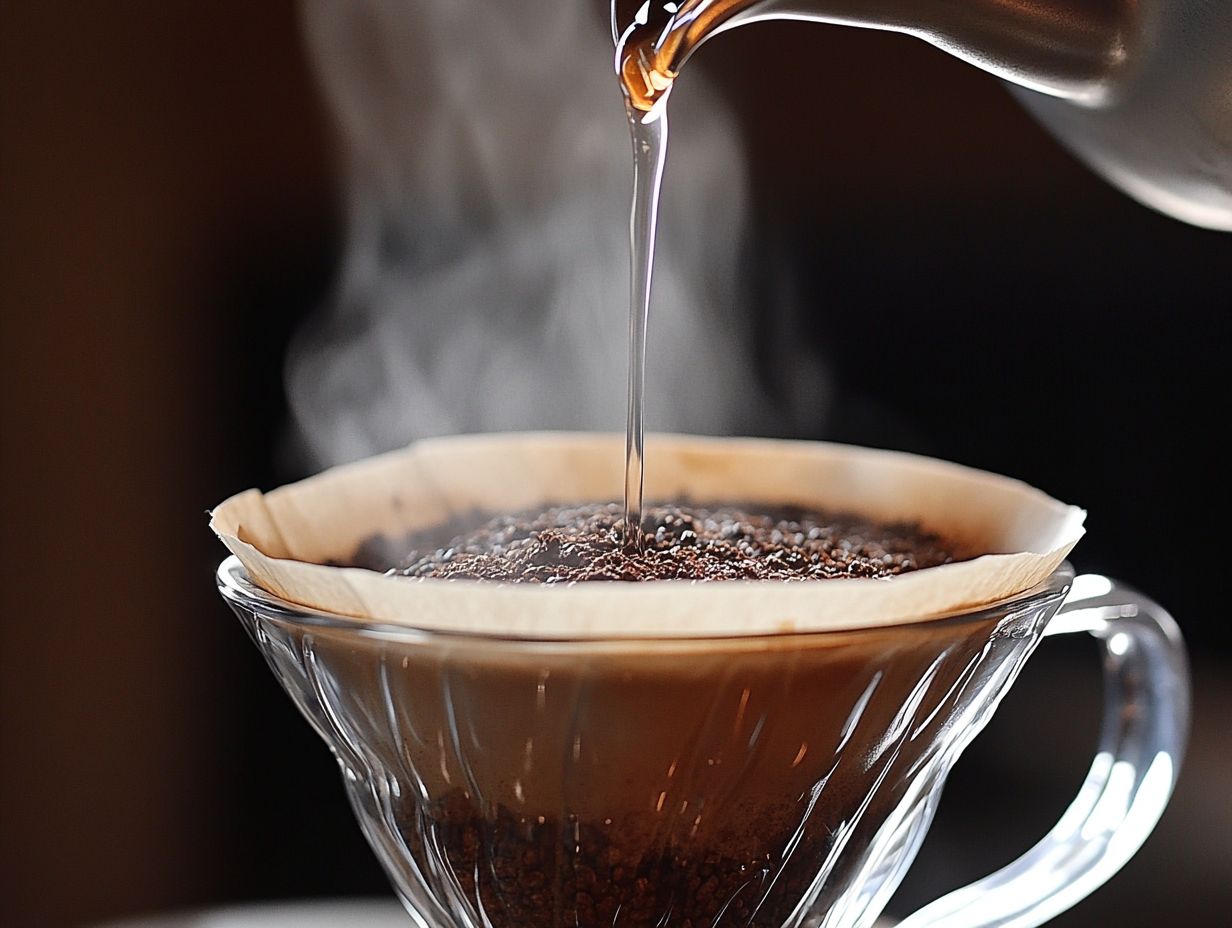
Pour-over coffee distinguishes itself from other brewing methods, like drip coffee, by emphasizing precision and control throughout the brewing process. This meticulous approach captivates coffee enthusiasts seeking to enhance their coffee experience.
Unlike automated coffee makers that do the work for you, the pour-over method encourages you to engage mindfully with each step, much to the delight of coffee enthusiasts and coffee connoisseurs. It gives you the power to adjust water temperature, brew time, and pouring technique, allowing you to extract the most vibrant flavor profile from your selected coffee beans.
What is the Difference in Taste?
The taste of pour-over coffee often strikes you as cleaner and more complex compared to other brewing methods, and that s largely due to your precise control over variables like extraction time and water quality. As a coffee enthusiast, you ll appreciate how this method highlights the subtle flavor notes and aromatic qualities meticulously brought out by your precise control over the brewing process. This results in a nuanced and truly enjoyable tasting experience.
Take, for example, a bright Kenyan coffee with its lighter roast; pour-over brewing really brings out its vibrant acidity and fruity notes, enhancing the overall flavor profile and allowing those delightful hints of berry or citrus to shine through. In contrast, a French press or other drip coffee methods might deliver a heavier-bodied experience that can overshadow those delicate flavors, resulting in a deeper, muddled profile.
Similarly, with a medium roast Ethiopian blend, pour-over enhances the floral and tea-like qualities that might otherwise be buried in other brewing methods. This delicate extraction process is what makes pour-over so remarkable, providing a platform for beans to express their origins and varietals in a symphony of taste.
What is the Difference in Brew Time?
The brewing time for pour-over coffee typically spans three to four minutes, a commitment that may seem longer compared to more automated methods like drip coffee, which often wraps up in under five. However, this slower approach to brew time is crucial; it allows the water to fully extract the rich flavors from the coffee grounds, resulting in a beautifully complex and full-bodied cup.
This process calls for your attentiveness and a genuine appreciation for the art of coffee making, where precision is paramount. Unlike French press, automatic coffee makers, or instant coffee methods that often prioritize speed over quality, pour-over requires you to carefully monitor both the water temperature and your pouring technique.
Every stage of the brewing process enhances the final flavor profile, transforming what could be a mundane caffeine fix into a true sensory experience. By allowing the water to flow steadily over the coffee grounds, you encourage optimal extraction, paving the way for a vibrant and aromatic cup that truly celebrates the nuances of your chosen beans.
What are the Benefits of Using the Pour Over Coffee Method?
Companies like Blue Bottle Coffee and Starbucks have popularized the pour-over method, showcasing its unparalleled ability to bring out the best in specialty coffee beans.
The pour-over coffee method presents a wealth of benefits that are sure to captivate any coffee lover, from rich flavor profiles to superior control over the brewing process.
By skillfully adjusting variables like grind size, water temperature, and brewing ratios, you can craft a personalized cup that perfectly aligns with your unique taste preferences.
This approach transforms brewing into a rewarding experience, appealing to both novices and seasoned aficionados alike, making it a favorite among coffee lovers.
Enhanced Flavor with Precision
One of the most remarkable advantages of the pour-over coffee method is its capacity to elevate the brew’s flavor, granting you precise control over the entire brewing process. By fine-tuning variables like water temperature and pouring technique, you can unlock the coffee’s full flavor potential. This results in a cup that is rich, aromatic, and bursting with character.
This careful method encourages you to try different coffee beans, each offering its unique notes and profiles. For example, using water heated to that perfect range between 195 F and 205 F, a temperature range often recommended by experts like James Freeman of Blue Bottle, can significantly enhance extraction efficiency, revealing floral or fruity undertones that other brewing methods might mask.
By agitating the coffee grounds while pouring, you can achieve a balanced extraction, steering clear of bitterness while promoting a fuller body.
Adjusting the grind size is also crucial; if the grind is too coarse, you risk under-extraction, while a grind that s too fine can lead to over-extraction. Therefore, experimenting with these parameters gives you the chance to discover the amazing flavor notes that lie within your coffee, taking your brewing experience to new heights.
Control over the Coffee Brewing Process
The pour-over coffee method offers you unparalleled control over the brewing process, allowing for adjustments that can profoundly influence your final cup. This hands-on approach gives you the power to explore various pour-over techniques, such as bloom pours and water flow rates, enabling you to craft your ideal flavor profile.
For example, when you vary the grind size of your coffee beans, a finer grind can enhance extraction, revealing bolder flavors, while a coarser grind will yield a milder taste. Adjusting the water temperature also elevates your brewing experience; water that s too hot may scorch the coffee, while cooler temperatures could leave some flavors underdeveloped.
Using a gooseneck kettle or a precise digital scale grants you the precision needed for controlled pouring, allowing you to manage the flow rate and ensure that the grounds are evenly saturated. Techniques like a staggered bloom where the initial pour lets gases escape before you continue brewing can unlock a more complex flavor profile.
The pour-over method becomes a delightful journey of experimentation that enhances your coffee experience.
Ease of Clean Up and Maintenance
When it comes to brewing methods, the pour-over technique truly shines with its simplicity and effectiveness! All you need is a coffee dripper, like the Hario V60, and some filters; the clean-up process is a breeze simply toss out the used coffee grounds and give the dripper a quick rinse. This means you can enjoy a hassle-free brewing experience.
This simple method not only saves you time but also makes every brewing session a joy, freeing you from the anxiety of a lengthy clean-up afterward. Once you’ve brewed your perfect cup, disposing of the filters takes mere seconds, and a quick rinse keeps your dripper spotless, free from residual oils and coffee particles.
For those who appreciate convenience, equipment crafted from glass or stainless steel by brands such as ESPRO or Chemex can go straight into the dishwasher for easy cleaning, adding another layer of simplicity to your routine. This remarkable blend of ease and efficiency is what makes pour-over coffee not only accessible but also thoroughly enjoyable, catering to both novice brewers and seasoned experts alike.
Portability and Flexibility
The portability of pour-over coffee equipment positions it as an ideal companion for travelers and outdoor enthusiasts who crave high-quality coffee on the go. With compact tools like the Hario V60 and lightweight coffee drippers at your disposal, you can effortlessly brew a fresh cup anywhere, ensuring that you never have to compromise on flavor while away from home.
Whether you find yourself camping in the great outdoors, enjoying a cozy stay at an Airbnb, or browsing the original Pike Place Market, the versatility of these brewing methods perfectly accommodates a range of scenarios. A travel kettle paired with pre-ground beans can significantly streamline your coffee-making process, allowing you to craft an aromatic brew within minutes.
Collapsible coffee filters and insulated mugs further enhance your experience, making cleanup and storage a breeze. For those who appreciate convenience, buying portable equipment guarantees that enjoying a caf -quality cup of coffee remains an exquisite possibility, even in unconventional settings.
These features not only simplify your routine but also elevate your travel adventures, infusing them with a touch of gourmet flavor. Don t miss out on the chance to elevate your coffee experience!
Are There Any Drawbacks to Using the Pour Over Coffee Method?
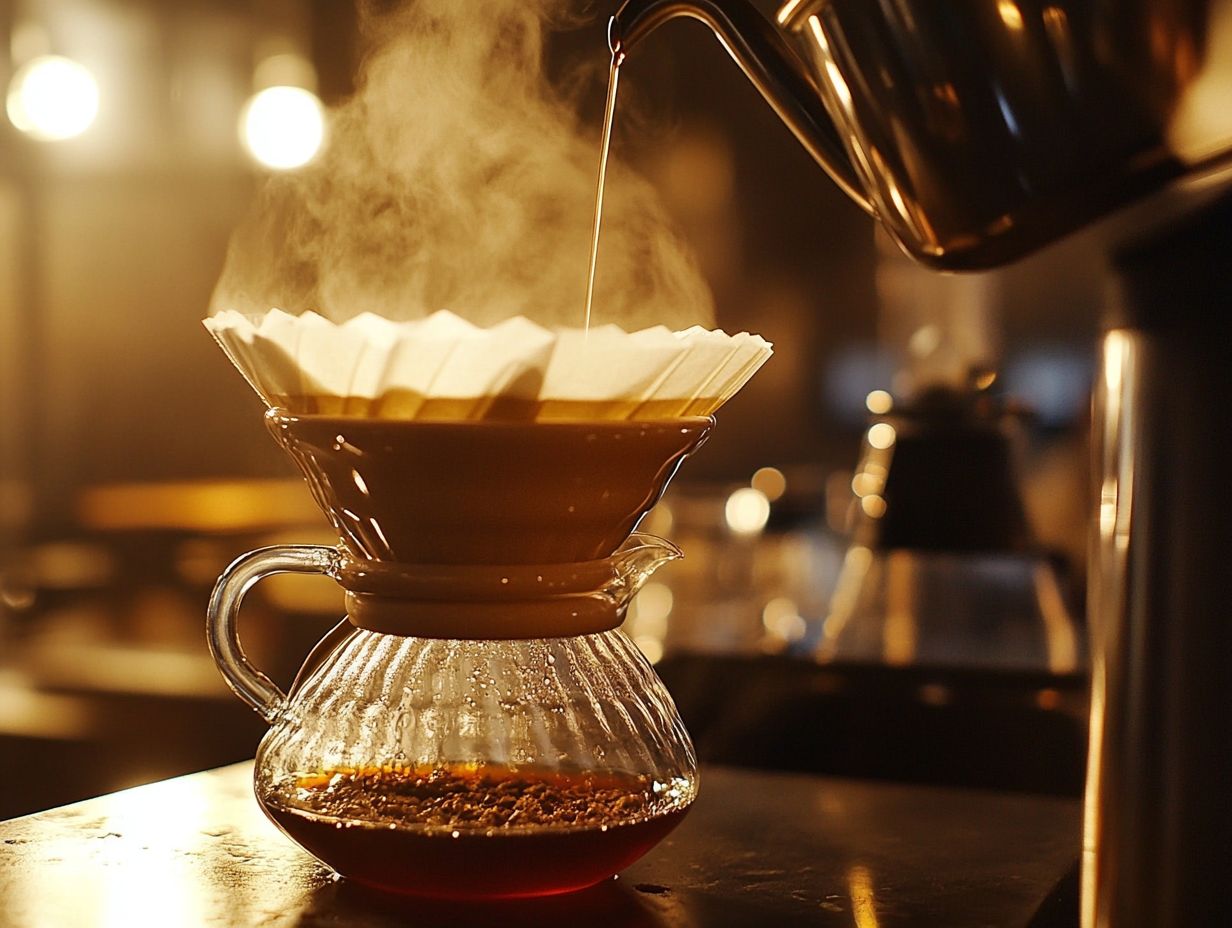
Despite the benefits, some coffee connoisseurs might find certain aspects less appealing. While the pour-over coffee method boasts numerous advantages, it also comes with its own set of drawbacks that you should weigh carefully before engaging in this manual brewing process.
One notable disadvantage is the increased time and attention and the need for specialized coffee brewing equipment required during preparation when compared to automated coffee makers. This aspect may deter those who favor the convenience of brands like Keurig or Nestl rather than the artistry of crafting their brew.
Requires More Time, Attention, and Equipment
The pour-over coffee method requires you to invest more time and attention during the brewing process. From grinding coffee to precise water temperature control, each step demands careful attention to detail to achieve that perfect flavor profile. If you re used to the speed and convenience of automatic coffee makers like Keurig or Starbucks, this manual approach might feel a bit time-consuming.
For those who appreciate the nuances of their brew, this careful process elevates a simple cup of coffee into a rich sensory experience. From choosing the right grind size to monitoring the water temperature and refining your pouring technique, each phase can significantly enhance the final product.
As a coffee drinker who values quality and depth of flavor, you ll likely find that the effort pays off, granting you greater control over the extraction (the process of drawing flavor from coffee grounds) and aroma. On the flip side, if you’re just after a quick caffeine fix, you might see this commitment as a hurdle, which can create a bit of a divide in preferences within the coffee community.
May Be More Expensive in the Long Run but Worth It
Investing in the pour-over coffee method might set you back a bit in the long run, mainly due to the initial expenditure on high-quality equipment like grinders, kettles, coffee filters, and those specialty coffee beans from top-notch brands like Soci t des Produits Nestl . For serious coffee enthusiasts, the rewards can certainly justify the investment. However, casual drinkers might find the financial commitment a bit intimidating.
As you delve deeper into this brewing method, you ll notice that costs can add up over time, especially when considering the need for additional accessories like a digital scale, grinder, coffee filters, kettle, and coffee dripper. The exciting world of premium beans from places like Blue Bottle Coffee can also vary significantly, impacting your overall coffee budget.
When you compare this to simpler brewing methods like drip coffee machines or French presses, which typically require a lower initial investment and less specialized gear, the financial implications really stand out. However, many argue that the superior taste and quality you get from pour-over brewing offer a level of satisfaction and enjoyment that makes the long-term costs worthwhile, particularly if you truly value your coffee brewing experience.
Mastering the Art of Pour-Over Coffee
Not Ideal for Making Large Quantities
One notable drawback of the pour-over coffee method is its limitation in brewing large quantities, which makes it less ideal for gatherings or events where multiple cups are in demand. Typically, each cup is brewed individually. This can lead to delays, leaving your guests waiting for their coffee a situation no host wants to face.
While the careful process of pour-over brewing allows for remarkable flavor control, it’s wise to consider alternative brewing methods. Automatic drip coffee makers offer a more streamlined approach for satisfying larger crowds.
For example, a French press or an automatic drip coffee maker can efficiently brew several servings at once without compromising on flavor. Batch brewing methods, like cold brew, shine at outdoor events or on warm days, providing a refreshing volume of coffee ready to serve without the wait.
Tips for Making the Perfect Pour Over Coffee
Ready to brew the perfect cup? Here are essential tips to elevate your pour-over coffee. If you re aiming to master the art of the perfect pour-over coffee, pay attention to the brewing ratios and overall brewing process to achieve optimal results.
By honing in on crucial elements like the quality of your coffee, the size of the coffee particles, the temperature of the water, and your pouring technique, you can elevate your brew to extraordinary levels of flavor and satisfaction.
Use Freshly Roasted Beans
Using freshly roasted beans is a game-changer for your coffee experience. The freshness directly influences both the flavor profile and aroma of your brew. Seek out local roasters or specialty coffee shops like Blue Bottle Coffee that offer high-quality, recently roasted beans to ensure you re enjoying the best flavor experience possible.
When sourcing these beans, it s wise to check the roast date, aiming for beans roasted within the last few weeks. This attention to detail preserves those vibrant flavors and elevates the overall sensory experience of your coffee.
To maintain maximum freshness, proper storage is just as crucial. Consider using an airtight container and keeping it in a cool, dark place to shield the beans from light and humidity. By prioritizing both quality sourcing and effective storage, you’ll unlock the full potential of your brews, transforming a simple cup into a rich and complex flavor journey, much like the experience described by coffee enthusiasts.
Experiment with Different Grind Sizes
Experimenting with different grind sizes is crucial for discovering the ideal balance in your pour-over coffee. Each grind can dramatically influence extraction and flavor. By adjusting the grind size from coarse to fine, you can explore a spectrum of flavor profiles and aromas, ultimately uncovering your preferred brewing style. This is a technique often utilized by coffee enthusiasts.
Variations in grind size affect water flow during the brewing process, which influences how quickly flavors are extracted. A coarser grind allows faster water passage, leading to a milder, less intense brew, while a finer grind increases surface area for water contact, resulting in bolder flavors that might be overwhelming for some. Ensuring optimal water quality is also key to achieving the best results.
Grasping this relationship invites you to fine-tune your brewing parameters. Experimenting with methods such as the Hario V60 or Chemex not only deepens your appreciation for the subtle differences but also elevates your entire coffee experience.
By following these tips, you can ensure a delightful pour-over experience, making every cup a moment to savor.
Preheat Your Equipment
Preheating your equipment is an essential step in the pour-over coffee process that many enthusiasts tend to overlook. However, it can significantly impact your brewing results. By taking the time to preheat the coffee dripper and kettle, you ensure that your hot water maintains a consistent temperature. This allows for even extraction and ultimately delivers a more flavorful cup. Brands like ESPRO and Hario offer excellent equipment for this purpose.
This practice is key to achieving ideal thermal stability during brewing, which is important for bringing out the rich flavors from your coffee grounds. When your equipment is preheated, it helps prevent those pesky temperature drops that occur when hot water first meets cooler surfaces. A stable brewing temperature enhances the extraction of oils and solubles and reduces the risk of under-extraction, resulting in a well-balanced and satisfying cup. Understanding the precise extraction process the way flavors are drawn from the coffee grounds is vital to mastering this.
Incorporate preheating techniques like rinsing the dripper with hot water and warming the brewing vessel into your optimal brewing routine. This is particularly important when using high-quality equipment like the Hario V60 or Chemex.
Master Your Pouring Technique

Mastering your pouring technique is vital for achieving consistent results in pour-over coffee. Your pouring style significantly impacts extraction and flavor. A controlled and steady pour using a gooseneck kettle allows for optimal saturation of the coffee grounds, ensuring an even brew. Incorporating techniques like the bloom pour can greatly enhance your results.
Experiment with various pouring techniques, such as the bloom pour and the circular pour, to unlock the full potential of your coffee beans. The bloom pour saturates the grounds before the full brew, enhancing gas release and extraction for a richer flavor profile. Meanwhile, the circular pour encourages even saturation and balanced extraction, crafting harmonious flavor notes. Brands like Keurig and Nestl have automated some of these techniques in their machines.
Each method affects extraction patterns and enhances the overall aroma and mouthfeel, making practice essential. By honing these techniques, you’ll discover unique qualities in every cup, allowing you to refine your skills for an exceptional brewing experience. This level of dedication is often seen in coffee enthusiasts.
Be Patient and Enjoy the Process
Being patient and fully immersing yourself in the process of making pour-over coffee is essential for truly appreciating the craft behind each cup. This method demands your time and attention, allowing you to connect with your coffee on a deeper level and savor the journey of extracting its unique flavors. Understanding the pour-over techniques can make this process even more rewarding.
Every step starting from selecting high-quality beans to watching the water elegantly cascade over them enhances your experience. The ritual transforms into a rewarding act of mindfulness, inviting you to indulge in the rich aromas and soothing sounds of the brewing process. This approach is often recommended by coffee connoisseurs and coffee lovers alike.
Dive into this rich experience today; each cup reveals a new story! As you refine your technique, you ll discover that each pour unveils new depths of flavor, turning an ordinary morning into a delightful exploration. This exciting journey fosters a deeper love for your coffee and creates treasured moments of tranquility amidst the hustle and bustle of daily life.
Frequently Asked Questions
What is the Pour Over Coffee Method?
The Pour Over Coffee Method is a manual brewing process that involves pouring hot water over freshly ground coffee beans in a single, slow, and controlled motion. This results in a rich and flavorful cup of coffee. This method is revered by coffee enthusiasts for its ability to produce a superior flavor profile.
Have your own tips or experiences with pour-over coffee? Share them with us! Your insights could inspire fellow coffee lovers.
What equipment do I need to explore the Pour Over Coffee Method?
To explore the Pour Over Coffee Method, you will need a pour over coffee dripper, paper filter, gooseneck kettle, scale, and freshly ground coffee beans. Brands like Chemex, Hario, and Blue Bottle offer excellent options for these tools.
Why should I use the Pour Over Coffee Method?
The Pour Over Coffee Method allows for a more hands-on and customizable brewing experience, resulting in a more flavorful and aromatic cup of coffee compared to other brewing methods. Its popularity is a testament to its ability to enhance the overall brewing experience.
How do I choose the right grind size for Pour Over Coffee?
The ideal grind size for Pour Over Coffee is medium-fine, similar to table salt. However, the grind size can also be adjusted depending on personal preference and the type of coffee beans being used. Experienced coffee enthusiasts often experiment with grinding coffee to find the perfect size.
What is the recommended water temperature for Pour Over Coffee?
The recommended water temperature for Pour Over Coffee is between 195-205 degrees Fahrenheit. This temperature range ensures proper extraction of the coffee beans’ flavors without scalding them. Monitoring the water temperature is critical for achieving the best results.
Can I use the Pour Over Coffee Method for any type of coffee beans?
Yes, the Pour Over Coffee Method can be used for any type of coffee beans. However, the flavors and aromas may vary depending on the type of beans used, their roast level, and origin. Coffee from regions like Pike Place Market often offers unique flavor profiles that can be highlighted using this method.

